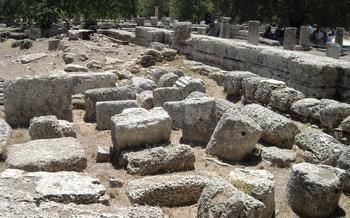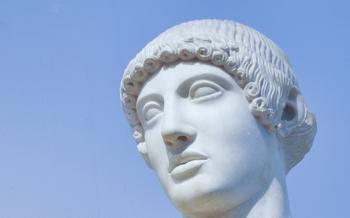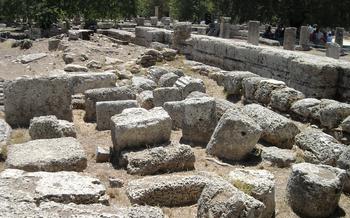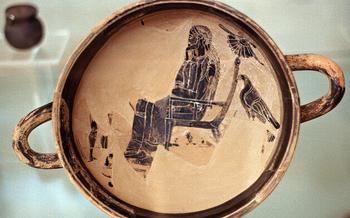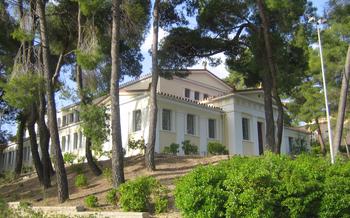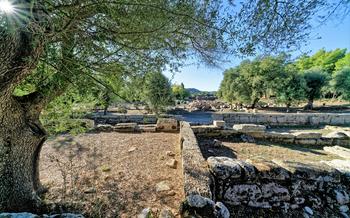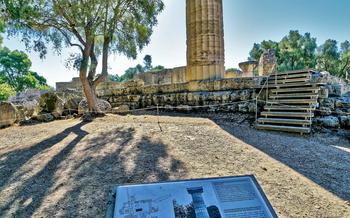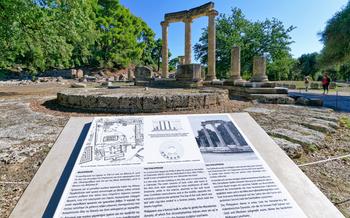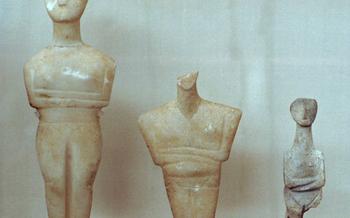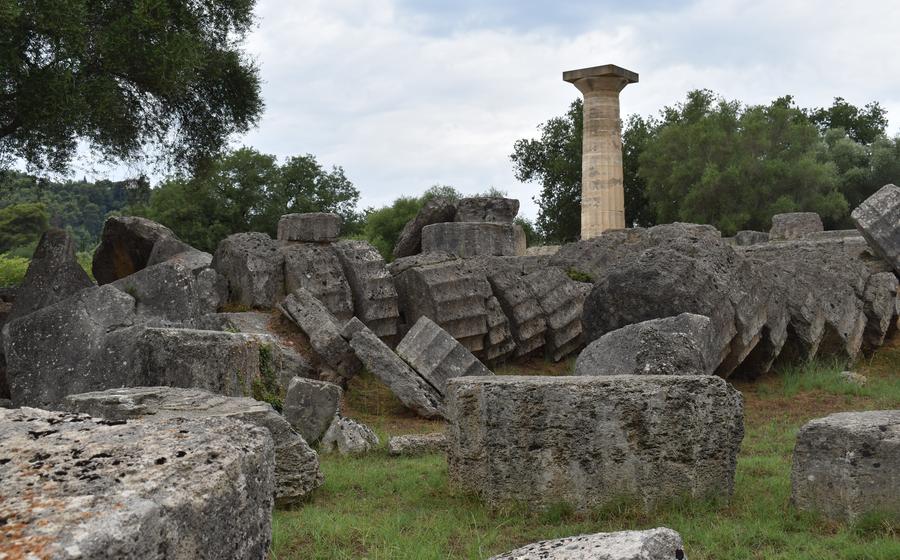
Temple of Zeus
- The Temple of Zeus: A Monumental Masterpiece
- Unveiling the History of the Temple
- Exploring the Architectural Marvel
- Corinthian Columns and Their Significance
- Elaborate Sculptures and Decorative Elements
- Symbolism and Mythology Depicted in the Artwork
- Witnessing the Statue of Zeus
- The Altar of Zeus: A Sacred Offering
- Participating in the Ancient Olympic Games
- Exploring the Archaeological Museum of Olympia
- Strolling Through the Ancient Stadium
- Visiting the Temple of Hera
- Admiring the Pelopion
- Learning About the Olympic Torch Relay
- Attending the Olympia Festival
- Dining in Olympia
- Accommodations in Olympia
- Insider Tip: Plan Your Visit
The Temple of Zeus: A Monumental Masterpiece
The Temple of Zeus, one of the Seven Wonders of the Ancient World, stands as a testament to the architectural prowess and religious devotion of the ancient Greeks. Built in the 5th century BC, this colossal temple was dedicated to Zeus, the king of the gods, and played a central role in the Olympic Games, the most prestigious athletic and religious festival in ancient Greece.
The temple's grand scale and intricate design reflect the importance of Zeus in Greek mythology and religion. Its massive columns, intricate sculptures, and impressive dimensions create an awe-inspiring sight that has captivated visitors for centuries. Within the temple, a colossal gold and ivory statue of Zeus, crafted by the renowned sculptor Phidias, once stood as a symbol of the god's power and majesty.
Unveiling the History of the Temple
The origins of the Temple of Zeus can be traced back to the 5th century BC when the Eleans, a powerful tribe in the region, decided to construct a magnificent temple to honor Zeus, the king of the gods. The construction began around 470 BC and continued for over a decade, with skilled architects and craftsmen working tirelessly to create this architectural masterpiece.
The Eleans played a crucial role in the development of the temple, providing financial resources and manpower to ensure its completion. They held the Olympic Games every four years, and the proceeds from these prestigious events were used to fund the construction and maintenance of the temple.
However, the temple faced its share of challenges over time. In the 3rd century BC, it was damaged by a devastating earthquake, and subsequent earthquakes and fires caused further destruction. In the 5th century AD, the temple was closed by the Roman emperor Theodosius II, who outlawed pagan worship throughout the empire.
Despite its decline, the temple remained an impressive sight, attracting visitors from around the world who came to marvel at its ruins. In the 19th century, archaeological excavations began at the site, revealing the temple's foundations, sculptures, and other artifacts that shed light on its history and significance.
Exploring the Architectural Marvel
The Temple of Zeus stands as an architectural masterpiece, showcasing unique features that set it apart from other ancient Greek temples. One striking element is its colossal size, measuring approximately 66 meters in length, 27 meters in width, and 20 meters in height. The temple's grand scale reflects the importance and reverence accorded to Zeus, the king of the gods.
Corinthian Columns and Their Significance
The temple's exterior is adorned with 38 majestic Corinthian columns, each reaching an impressive height of 5 meters. These columns are distinguished by their intricate capitals, featuring acanthus leaves and scrollwork. The Corinthian order, the most ornate of the three classical Greek orders, was rarely used in temple architecture, making the Temple of Zeus a notable exception.
Elaborate Sculptures and Decorative Elements
The temple's pediments, or triangular gables, were adorned with elaborate sculptures depicting scenes from Greek mythology. The eastern pediment showcased the birth of Zeus, while the western pediment depicted the battle between the Centaurs and the Lapiths. These sculptures, carved with exceptional skill and precision, added a dynamic and narrative element to the temple's facade.
Symbolism and Mythology Depicted in the Artwork
The sculptures and decorative elements of the Temple of Zeus were not merely aesthetic embellishments but also served as powerful symbols and conveyors of religious and mythological messages. The presence of Zeus's thunderbolt, the eagle, and the bull symbolized his divine power and authority. The intricate friezes and metopes depicted stories from Greek mythology, reinforcing the temple's connection to the realm of the gods.
Witnessing the Statue of Zeus
The Temple of Zeus was home to one of the most awe-inspiring wonders of the ancient world: the colossal statue of Zeus himself. Crafted by the renowned Greek sculptor Phidias, this masterpiece stood an astonishing 40 feet tall and radiated an ethereal presence within the temple. Constructed from gold and ivory, the statue depicted Zeus seated upon a magnificent throne, his countenance exuding both majesty and benevolence.
Phidias meticulously carved every detail of Zeus's powerful physique, from the rippling muscles of his arms and chest to the intricate folds of his flowing robes. The statue's hair and beard were rendered with such precision that individual strands seemed to dance in the flickering light of oil lamps. Zeus's eyes, crafted from precious stones, sparkled with a divine radiance, captivating all who beheld them.
The statue was not merely an artistic marvel but also held deep religious significance. It embodied the essence of Zeus, the king of the gods, and served as a focal point for worship and devotion. The people of Olympia would flock to the temple to offer prayers and sacrifices, seeking the favor and protection of the almighty Zeus.
Sadly, the fate of this extraordinary statue remains shrouded in mystery. It is believed that the statue was eventually dismantled and removed from the temple, possibly during the 5th century AD when the Olympic Games were suppressed. The exact circumstances surrounding its disappearance are unknown, and the statue's whereabouts have never been definitively determined.
Despite its absence, the legacy of the Statue of Zeus endures. It remains one of the most iconic and revered works of ancient Greek art, forever etched in the annals of history as a testament to human ingenuity and the enduring power of mythology.
The Altar of Zeus: A Sacred Offering
In the heart of Olympia, near the Temple of Zeus, lies another significant monument: the Altar of Zeus. This monumental structure served as a central point for religious ceremonies and rituals dedicated to the king of the gods. Built in the 6th century BC, the altar holds a prominent position in the sacred precinct.
Its design is both impressive and symbolic. Constructed from massive limestone blocks, the altar rises in a series of stepped terraces, culminating in a large platform at its summit. This platform, measuring over 21 meters in length and 10 meters in width, provided ample space for offerings and sacrifices to Zeus.
The altar's location, directly in front of the Temple of Zeus, underscores its importance in the religious ceremonies held in Olympia. It was here that priests and officials would gather to perform rituals, offer sacrifices, and seek divine favor from Zeus. The smoke rising from the altar symbolized the prayers and offerings ascending to the heavens.
The structure of the altar itself is a testament to the skill and craftsmanship of the ancient Greeks. The massive limestone blocks are precisely cut and fitted together without the use of mortar, demonstrating the engineering prowess of the time. The altar's grand scale and imposing presence further enhance its significance as a place of worship and devotion.
Participating in the Ancient Olympic Games
The ancient Olympic Games, held in Olympia every four years, were a grand spectacle that brought together athletes, spectators, and religious pilgrims from across the Greek world. These games, which predate the modern Olympics, held deep religious and cultural significance, honoring the Greek gods, particularly Zeus, and celebrating the ideals of athleticism and sportsmanship.
The Olympic Games featured a variety of athletic competitions, including running races, wrestling, boxing, discus and javelin throwing, and chariot racing. These events were held in the ancient stadium of Olympia, a marvel of engineering that could accommodate tens of thousands of spectators. The games were open to freeborn Greek men, and participation was considered a great honor.
Beyond the athletic competitions, the Olympic Games were also a time for religious ceremonies and rituals. Participants and spectators alike would make offerings to Zeus and other deities, seeking their favor and blessings. The games also served as a platform for cultural exchange, as people from different city-states came together to share ideas, traditions, and innovations.
The legacy of the ancient Olympic Games has had a profound impact on the modern world. The revival of the Olympic Games in the late 19th century was inspired by the ideals and traditions of the ancient games, and the modern Olympics continue to embody the spirit of athleticism, sportsmanship, and international unity that characterized their ancient predecessor.
Exploring the Archaeological Museum of Olympia
The Archaeological Museum of Olympia is a treasure trove of artifacts and exhibits that provide a comprehensive insight into the history and culture of Olympia. Situated adjacent to the ancient site, the museum houses a remarkable collection of sculptures, pottery, bronze objects, and other artifacts excavated from the Temple of Zeus and other significant locations in Olympia.
Among the highlights of the museum is the collection of sculptures from the Temple of Zeus, including fragments of the pediments and metopes that once adorned the temple. These sculptures depict scenes from Greek mythology and provide a glimpse into the artistic and religious traditions of ancient Greece. Other notable exhibits include the Hermes of Praxiteles, a stunning marble statue of the Greek god Hermes, and the Nike of Paionios, a bronze statue of the goddess Nike.
The museum also houses a collection of pottery and bronze objects that offer insights into the everyday life and customs of the ancient Greeks. Visitors can admire a variety of ceramic vessels, including amphoras, kraters, and oinochoes, as well as bronze tools, weapons, and armor. These artifacts provide a tangible connection to the people who lived and worked in Olympia centuries ago.
A visit to the Archaeological Museum of Olympia is an essential complement to exploring the ancient site. It allows visitors to delve deeper into the history and culture of Olympia and to gain a better understanding of the significance of this sacred place in the ancient world.
Strolling Through the Ancient Stadium
Situated a short walk from the Temple of Zeus, the Ancient Stadium of Olympia stands as a testament to the athletic prowess and competitive spirit of the ancient Greeks. Constructed in the 5th century BC, this impressive venue hosted the legendary Olympic Games for over a millennium, attracting athletes and spectators from across the Hellenic world and beyond.
With a capacity to accommodate over 45,000 spectators, the stadium's design showcased remarkable engineering and architectural skills. The track, measuring approximately 212 meters in length, was lined with a 20-centimeter-high stone barrier to prevent cheating and ensure fair competition. The starting line, marked by a series of parallel grooves, still bears the imprints of ancient athletes' feet, providing a tangible connection to the past.
The seating arrangements reflected the social hierarchy of the time. The front rows were reserved for VIPs, including priests, judges, and wealthy citizens, who enjoyed the best views of the competitions. The upper tiers were occupied by ordinary spectators, who would cheer on their favorite athletes and soak in the excitement of the games.
Beyond its sporting significance, the Ancient Stadium held deep religious and cultural importance. The Olympic Games were not merely athletic competitions but also sacred rituals honoring Zeus, the king of the gods. The stadium served as a sacred space where athletes and spectators came together to celebrate the Olympic ideals of excellence, sportsmanship, and unity.
Today, visitors to the Ancient Stadium can wander through its ruins and imagine the roar of the crowd as ancient athletes competed for glory and honor. It is a place where history and mythology intertwine, inviting travelers to step back in time and experience the essence of the Olympic spirit.
Visiting the Temple of Hera
Located just a short walk from the Temple of Zeus, the Temple of Hera is another significant ancient structure in Olympia. Dedicated to the goddess Hera, wife of Zeus and queen of the gods, this temple holds historical and religious importance. Built in the 7th century BC, it predates the Temple of Zeus and is considered one of the oldest temples in Greece.
The Temple of Hera features a unique architectural style, showcasing a mix of Doric and Ionic elements. Its well-preserved columns and pediments display intricate carvings and sculptures, depicting mythological scenes and figures. Inside the temple, visitors can admire the remains of an ancient altar, where offerings and sacrifices were made to Hera.
Beyond its religious significance, the Temple of Hera is also associated with the Olympic Games. It was believed that Hera presided over the games, and her temple served as a gathering place for athletes and spectators before and after competitions. The proximity of the Temple of Hera to the stadium highlights the close connection between religion and sports in ancient Greece.
In comparison to the grand scale of the Temple of Zeus, the Temple of Hera is more intimate and serene. It offers visitors a glimpse into the worship practices and rituals of ancient Greece, honoring the powerful goddess Hera and celebrating the spirit of the Olympic Games.
Admiring the Pelopion
The Pelopion is an ancient monument located near the Temple of Zeus in Olympia. It is a circular structure built in the 6th century BCE to honor Pelopas, the legendary founder of the Peloponnese region. The Pelopion is a significant historical site that offers insights into the religious and cultural practices of ancient Greece.
The monument consists of a circular platform surrounded by a ring of 14 Doric columns. In the center of the platform is a large altar, where offerings and sacrifices were made to Pelopas. The Pelopion was likely used for religious ceremonies and rituals honoring the hero and commemorating his role in the foundation of the Peloponnese.
Archaeological excavations conducted at the Pelopion have uncovered various artifacts and offerings, including pottery fragments, bronze objects, and terracotta figurines. These findings provide valuable insights into the religious practices and rituals associated with the monument and offer a glimpse into the beliefs and customs of the ancient Greeks.
Visiting the Pelopion is a unique opportunity to explore an important historical site and learn about the legendary figure of Pelopas and his significance in Greek mythology and history. The monument's circular design and central altar create a sense of reverence and awe, allowing visitors to connect with the past and appreciate the religious rituals and traditions of ancient Greece.
Learning About the Olympic Torch Relay
The Olympic torch relay is a stirring tradition that traces its roots to ancient Greece. In those times, a sacred flame was lit at the Temple of Hera in Olympia and carried by runners to various cities and sanctuaries throughout Greece, symbolizing the commencement of the Olympic Games.
Today, the torch relay has evolved into a global event, mirroring the spirit of unity and sportsmanship that characterized the ancient games. The relay begins in Olympia, where a flame is ignited using the sun's rays and a parabolic mirror, replicating the ancient method. From there, the torch embarks on a journey across continents, carried by a succession of torchbearers who pass it along, creating a sense of anticipation and excitement leading up to the Olympic Games.
The route of the torch relay is meticulously planned, ensuring that the flame traverses significant landmarks and cities, spreading the Olympic spirit far and wide. Along its path, the torch is greeted with fanfare and enthusiasm, as people from all walks of life come together to celebrate the shared ideals of the Olympic Games.
Attending the Olympia Festival
Every four years, the ancient city of Olympia comes alive with the magic of the Olympia Festival, a vibrant celebration of Greek heritage and culture. This spectacular event transports visitors back in time, allowing them to experience the spirit of the ancient Olympic Games. During the festival, the streets of Olympia are adorned with colorful decorations, and the air is filled with music, laughter, and the excitement of anticipation.
The festival showcases a diverse range of performances, exhibitions, and events that explore the rich history and traditions of Greece. Visitors can witness traditional Greek dances, listen to captivating concerts, and admire stunning art exhibitions that celebrate the country's artistic heritage. There are also opportunities to participate in workshops and demonstrations that delve into ancient Greek crafts, such as pottery, weaving, and metalworking.
One of the highlights of the Olympia Festival is the symbolic lighting of the Olympic torch, a ceremony that evokes the spirit of the ancient Olympic Games. The torch, which represents the continuity of the Olympic tradition, is ignited in the Temple of Hera and then carried by runners on a relay route that traverses Greece before reaching its final destination at the Olympic stadium in Athens.
Attending the Olympia Festival is a truly immersive experience that allows visitors to connect with the past and celebrate the enduring legacy of ancient Greece. Whether you are a history buff, a culture enthusiast, or simply someone who appreciates a lively festival atmosphere, this event is sure to leave you with lasting memories.
Dining in Olympia
When in Olympia, indulging in the local cuisine is a must. The town offers a range of restaurants and tavernas serving traditional Greek dishes made with fresh, locally sourced ingredients. From hearty stews and grilled meats to seafood specialties and vegetarian delights, there's something to satisfy every palate.
For a taste of authentic Greek cuisine, head to one of the many family-run tavernas in the town center. These cozy establishments offer a warm and welcoming atmosphere, where you can savor traditional dishes like moussaka, pastitsio, and souvlaki, all prepared with love and care.
If you're a seafood lover, you'll be in paradise in Olympia. The town is located on the coast, and the local restaurants serve up the freshest catches of the day. From grilled octopus and calamari to succulent shrimp and lobster, there's no shortage of delicious seafood options to choose from.
For those with a sweet tooth, Olympia has plenty to offer as well. Be sure to try the local honey, which is renowned for its rich flavor and aroma. And don't miss out on the traditional Greek pastries, such as baklava, kataifi, and loukoumades, which are sure to satisfy your cravings.
Whether you're looking for a casual meal or a fine dining experience, you'll find plenty of options in Olympia to suit your taste and budget. So, come hungry and prepare to indulge in the culinary delights of this historic town.
Insider tip:
- For a unique dining experience, try one of the many rooftop restaurants in Olympia. These restaurants offer stunning views of the town and the surrounding countryside, making your meal even more memorable.
Accommodations in Olympia
Olympia offers a range of comfortable accommodations to suit every traveler's needs and budget. From modern hotels to charming guesthouses, there are plenty of options to choose from. To find the best deals, it is advisable to book your stay in advance, especially during the peak tourist season.
For those seeking convenience and proximity to attractions, hotels located in the city center are a great choice. These hotels often offer amenities such as rooftop terraces with stunning views of the ancient ruins, swimming pools, and easy access to restaurants and shops.
If you prefer a more authentic experience, traditional guesthouses are a delightful option. These cozy accommodations often feature charming courtyards, traditional Greek architecture, and warm hospitality. They provide a unique opportunity to immerse yourself in the local culture and connect with the friendly people of Olympia.
When choosing your accommodation, consider your budget, desired amenities, and proximity to the attractions you plan to visit. Whether you opt for a luxurious hotel or a quaint guesthouse, you're sure to find a comfortable and welcoming place to stay in Olympia.
Insider Tip: Plan Your Visit
When to Visit: The best time to visit Olympia is during the spring (April-May) or autumn (September-October) when the weather is pleasant and the crowds are smaller. Summers can be hot and crowded, while winters can be cold and wet.
Avoiding Crowds: To avoid the crowds, visit Olympia early in the morning or late in the afternoon. You can also visit on a weekday instead of a weekend.
Duration of Stay: A stay of at least two days is recommended to fully explore Olympia and its surroundings. This will give you enough time to visit the Temple of Zeus, the Archaeological Museum, the Ancient Stadium, and the Temple of Hera.
Guided Tours: Guided tours are available for the Temple of Zeus, the Archaeological Museum, and the Ancient Stadium. These tours provide valuable insights into the history and significance of these sites.
Resources: Before your visit, be sure to do some research on Olympia and its history. This will help you make the most of your visit. There are many books, websites, and documentaries available on the subject.
